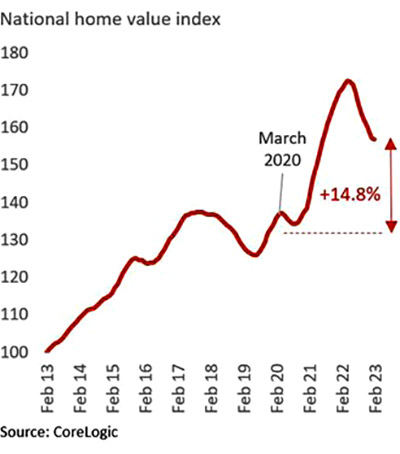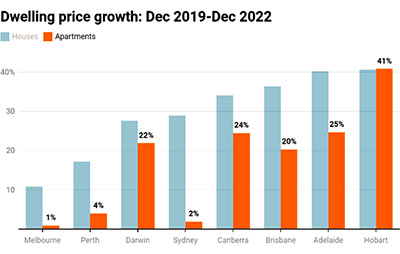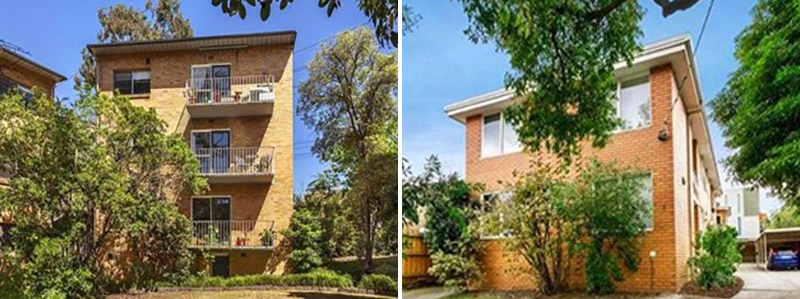With one in ten properties worth buying, where should investors be looking in 2023?
With just 8 to 10 per cent of properties deemed to be of investment-grade standard, API Magazine columnist Miriam Sandkuhler identifies the suburbs, budgets and property types that investors should be looking at in 2023.
Is there a case for investing in property in 2023? There is but only if you’re cautious and prepared to exercise a little patience.
What’s wrong with the market at the moment?
The short answer is rapidly rising interest rates.
The negative impact of rates has been felt most keenly in the “trophy home” sector and many of the areas that saw the greatest gains through the 2020 - 2021 “cash splash” period.
In Melbourne, 100 of 392 suburbs have a dwelling median value above $1 million, a drop from 144 last year.
It’s a similar pattern in Brisbane, where the number of suburbs with values above $1 million fell from 65 to 40.
A great example of where the tide is rolling back is the Sydney suburb of Bayview. This picturesque location had a median value for dwellings of $1 million a year ago only to see that fall back to $765,000 today.
The other end of the market will be in focus soon. There are some 900,000 mortgage holders still enjoying the emergency low interest rates prevalent during Covid thanks to fixed term contracts.
Most of these will end in the second half of this year and the rise of 3 per cent - 4 per cent on their mortgage rates will disproportionately hit the newer estates on the fringes of cities.
Timing is key for property investors in 2023
At face value, this all makes for grim reading, but if you’re an investor who likes to buy when the time is right, 2023 may prove a good opportunity.
The first thing to note is the losses this year are paring back some of the extraordinary rises around the pandemic and the huge amount of cash flung at the economy.

Also bear in mind the jump in prices and retreat that followed affected some areas much more than others.
But even with the recent price falls, we are still transacting properties at higher prices than we were two years ago.
Taking a look at the underlying dynamics to see where the market could be headed next, a quick audit shows some real positives.
Growth in new households is moving again thanks to migration.
The economy remains solid with very low unemployment and high business profits.
And the interest rate cycle looks like it’s about to peak. Higher rates than we’ve become used to will impact the economy and employment but we’re still likely to end up in solid territory.
Rents are still booming
While the cost of a mortgage has risen off the floor, so has something else for investment property owners – rent, thanks to the dynamics of supply and demand.
In the year to June 2022, the number of properties available for rent in Sydney fell 13.8 per cent and in Melbourne 13.9 per cent. This is partly due to the increasing numbers of properties leaving the rental market and moving to short term accommodation.
But the result is clear; lots of renters, including recent migrants, are fighting for fewer places.
Since September 2020, asking rents have jumped 22.2 per cent, the biggest upswing on record. The push is broad-based, with both metro areas and regional locations showing strong growth off the back of record-low vacancy rates.
Units offering investment potential
That jump in rents is one of the reasons for relatively solid results for units in the last 12 months.

Investors tend to favour apartments and townhouses, attracted by affordable prices and owners’ corporations (strata) taking care of much of the maintenance.
But they’re also favoured by city-based first home buyers, attracted to affordable property in sought after locations.
Apartments prices haven’t risen nearly as fast as houses across most cities and towns in the last few years, which underlines their affordability.
| Suburb | Median unit price growth |
|---|---|
| Essendon North | -17.9% |
| Box Hill | -17.4% |
| Canterbury | -17.1% |
(Annual, June 2022)
While some units are performing well, others aren’t. Take a look at these three locations in Melbourne that have seen a flush of newer, smaller apartments hitting the market in recent years.
Where there has been intense development, unit prices have underperformed.
So, what type of units should investors target? It’s those unglamourous yet comforting 20th century apartments spread across the inner and middle suburbs.
Investors should focus their search on two-bedroom units with well-designed living space, street appeal, a balcony or outdoor space, and a car space in a high amenity location.

Regional differences set to widen
The biggest winner of the last two years has been houses in regional centres. But will this continue?
Not this year with the rise of interest rates hitting hard. Nonetheless, there are good opportunities for shrewd investors who can look beyond 2023.
The tree change trend, so strong in 2020, has moderated and we are seeing a pullback across most regional centres. While the signs in small towns and hamlets aren’t great, larger regional cities like the Gold Coast, Albury and Ballarat are proving more resilient thanks to their broader local economies and the return of overseas students.
I turned to my colleague, Anjay Zazulak to get a better feel for the dynamics at play in a significant regional centre, Albury-Wodonga.
Anjay was upbeat, telling me, “We are still seeing good sale prices in Albury-Wodonga with investors securing properties with strong fundamentals.”
“Because we’re a border town, Albury-Wodonga gets two of everything; hospitals, universities, TAFEs, and we have strong employment anchored by the ATO and defence.”
“The rental environment is excellent for landlords; we essentially have a zero vacancy rate.”
So, what property types and price ranges should investors target?
“There are two options which stand out,” Anjay said.
“Around the $425,000 to $550,000 mark, you can get a three-bedroom, one-bath house on 600 to 700sqm boasting a rental return of 5 to 6 per cent.
“For investors with bit more budget, say $600,000 to $800,000, there are some great three- or four-bedroom, one- or two-bath houses with the potential to add value in areas like East Albury, Central Albury or pockets of South Albury.”
Metro three-bedroom houses a buyer target
The other great opportunity lies with three-bedroom houses on decent blocks in family-friendly metropolitan locations and some commuter locations close to metro areas.
There are essentially two types to focus on, as my Queensland colleague, Andrew Vasiliades put it to me.
“For investors with a budget around the $600,000-mark, emerging growth centres like Caboolture and Morayfield offer good scope as they have benefited from a big infrastructure spend, their proximity to the Sunshine Coast and are just a 50-minute drive to the Brisbane CBD.
“Investors should narrow their search to the older, established neighbourhoods not the newer estates.
“Look for houses on 600sqm blocks with the right orientation and street appeal, avoiding streets with social housing.
“At around the $900,000 mark, start with suburbs like Chermside West, which is 10 kilometres from CBD with a big hospital and lots of good schools.
“There are also similar, high rated bayside areas to look at, including Birkdale and Cleveland, and for investors with around $1 million, Manly West and Wynnum.
“These areas have great long term growth prospects for owners of well-chosen properties.”
That advice rings true for Melbourne, although investors will need a bigger budget. Starting at $1 million, it’s worth targeting a minority of homes in certain areas, including Kingsville, Bentleigh, Keilor East, Cheltenham, Forest Hill and Blackburn.
But there are also affordable houses with strong investment potential around the $800,000 mark in suburbs like Albion, Glenroy and Frankston. What these areas have in common is great access to the city, employment and public transport and family friendly 20th century houses.
So, property is a good bet?
Yes, it is but only for investors prepared to look past the current numbers and focus on the 8 per cent to 10 per cent of properties that meet what we call “investment-grade” standard.
For the owners of the right houses or units, the future looks a little cloudy over the next six months but much brighter in the years ahead.





















